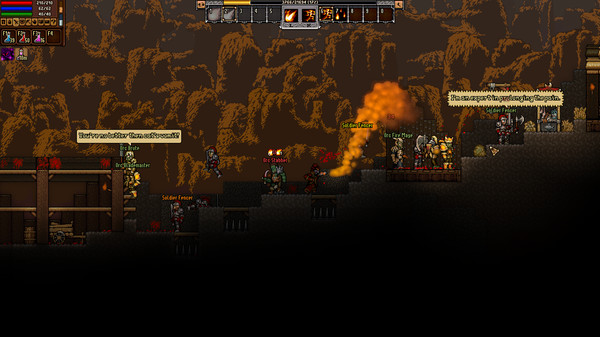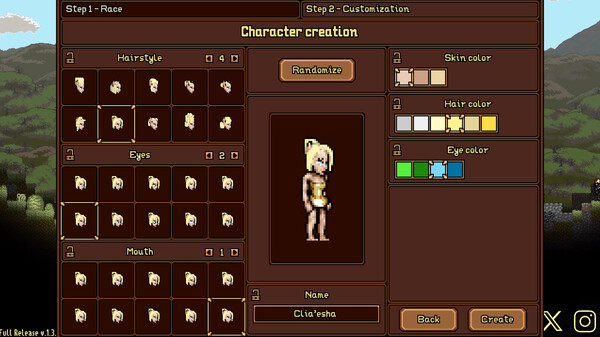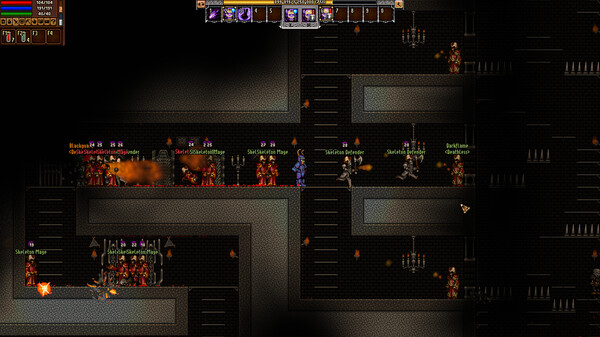I really can't help but compare this game to Terraria for good and ill. It looks a lot like Terraria and has too many similar mechanics and activities for it to be a coincidence. This is one of those games where I get the sense the devs played another game (in this case, Terraria) and got the idea in their head of how they'd have built it, instead. The most obvious change is the existence of a plot/story. This leads to a weird dichotomy in gameplay, because the "local map" you play on is relatively small, but you can open up a world map and go to different local maps by clicking on a grid location. Most are procedurally-generated "sandbox" maps, which are basically just like Terraria where you can dig, explore, build your own house, etc. Then, there are plot maps that are always the same, almost all the objects are fixed in place without you being able to dig or place any blocks and most furniture being non-interactive. I find this quite jarring. In particular, some areas in the plot maps, despite the game training you to stop trying to mine, you're meant to dig through special walls, (with "muck" blocks or the like, while the similar-looking mud blocks are still invincible.) You're meant to find all the secrets in these plot areas, but since the game changes the rules on you depending on location, it's hard to remember all the tricks you're supposed to be using to search. The plot is also... not fantastic. It goes for a rather misanthropic "comedic" tone that leaves me not caring if I save or wind up dooming everyone. It's like Monty Python's take on mud-stained illiterate peasants without the charm or flamboyance, and instead a general disdain for everyone. The first town has a town idiot who steals women's clothing, introduces a guy as the local wife-beater whose violence everyone just ignores, and instead everyone warns you to stay away from the brutal authoritarian guard captain... who's also the only one with actual main plot quests. As other reviews mention, there's little role-play here, as you only get choices during quest dialogue, and your options are effectively "agree to whatever they say," "agree but complain about it," or "refuse to do the quest." There's one main plot quest per chapter where you get A choice (basically "kill everyone" or "don't",) but otherwise, refusing either says "OK, I'll wait here until you agree" or "tough, do it anyway." Another huge change is the RPG leveling system. You have a race that gives bonuses, (or penalties for the gnome,) but the rest is based upon gear, finding scrolls (rewards for quests or in treasure chests in sandbox maps,) and spending talent points in one of seven talent trees. There are a heavy and light weapon tree, a general mobility/recovery "combat" tree, and four magic trees: fire, ice, nature, and necromancy. Because of how combat works, these have serious balance issues. That brings me to the biggest change: Combat. Unlike the NES-inspired Terraria, you can walk through enemies just fine, you only take damage if you're there when an enemy launches one of their heavily-choreographed attacks. The combat is more like one of those "2d Soulslike" games where you right click to block and get a dodge roll where I-frames are second tier in the "combat' tree. It seems designed to want you to dodgeroll, then stab the enemy in the back before waiting for the next attack and rolling again, although its stamina regeneration can be limiting. Or you can just play a nature or necromancy mage and just drop summons on the enemy while hiding on a ledge like a total coward. Even if you're a melee brute, you can easily just take a time out by jumping up on a ledge for a breather, as nearly all the enemies lack the scripting to understand how to jump more than a couple tiles up. Your MP and HP regenerate, theirs doesn't. It's like if going back to bonfires in Dark Souls didn't respawn enemies, you just clear them out once and they're gone forever. This is both good and bad; Enemies in Terraria were often more annoying than threatening. I wound up just avoiding caves and tunneling blindly through the solid stone to pick up random metals I happened to bumble on rather than constantly fight unending streams of monsters while I'm trying to get some mining done. Having the ability to just kill all the monsters in a given chamber and mine in peace means I'm not sick to death of the combat and actively seeking to avoid it. On the other hand, no respawns mean clearing a map makes it completely dead with no danger and nothing to do but continuously farm crops. I find myself missing those periodic monster-spawning events like blood moons from Terraria so that there could be some peaks of action spacing out valleys of farming. The maps are also gated by area. This means that in the starting province, I dig down to see how far down the bottom of the map is, only to find that in those maps, once you hit a certain depth, content just stops . You can only find tin, copper, salt, and coal in those maps, and if you go too deep, you just stop finding anything but stone and dirt. No lava or underworld at the bottom, the boundary is just boredom. This results in a sort of forced pacing, because you can easily spin jute into burlap and gain weaving skills, which unlocks the ability to spin linen, but you don't get flax until the next province. Meanwhile, you could focus on getting to the next province as fast as possible by just exploring sandbox maps for chests with map fragments (10 fragments to get to the next province, easily obtained in even a single sandbox map, of which dozens are in each province,) but when you get there, if you hadn't spent time farming jute and grinding weaving, you couldn't use the linen you found, anyway. You're time-gated behind both, and neither has anything to do with the main plot and quests. You're forced to split your time, which, if handled deftly might be a brilliant way to keep the game from getting too stale, but if there's one thing in this grab-bag of systems you don't like, it can repeatedly force you to do stuff like go mining for sandbox chests for map shards. There are a lot of decorative items, and obviously, the devs loved setting up tons of detail in their hand-made plot maps, while seemingly all the stuff you see you can eventually build with enough skill ranks and materials. The issue is, the game isn't built to let you have a home base - you can't carry rabbits from Splinterville back to your Woodsbury-area hut, so you need to build a new base in every province to get all the resources, and you can't mark a base with anything more than a tiny icon in the corner of a grid spot. Also, because of the aforementioned lack of respawning enemies, raids where you defend your giant castle from assault like Terraria are right out. It winds up making you feel like spending time actually using the intricate decorations are a waste of effort since you never need them and will just be moving on, anyway. Ultimately, I still find it interesting, with a clunkiness in combat and the relatively low amounts of combat being the weaker points of the game. It's strong point, however, is the fusion blend of genres and the simple fact that I still just plain like this kind of freeform sandbox explorer/builder with a side of RPG build crafting.
Expand the review


























